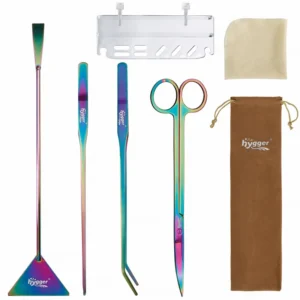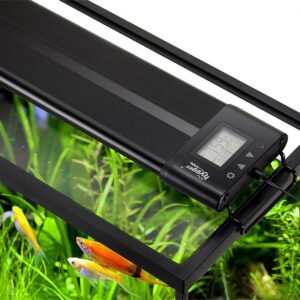hygger has revolutionized the budget-friendly aquarium market over the past few years, transforming a lighting category once dismissed as unsuitable for planted tanks into a trusted and viable option.
Content Table
hygger’s range of budget-friendly lights is now widely used by planted tank enthusiasts to grow lush, healthy aquariums.
This post is by Shaun, the owner of Glass Box Diaries, who currently uses four hygger 957 aquarium lights to grow thriving plants in his aquariums.

hygger 957
Why I Chose The hygger 957
I chose the hygger 957 for this aquarium because it delivers plenty of power, offers full-spectrum lighting to support plant growth, includes a built-in timer, and is easily customizable—all key features I was looking for.
From the start, I knew I’d be working with a 30-liter (8 US gallon) aquarium measuring 30cm wide and 30cm deep.
This size can be a challenge for many budget-friendly lights, as models narrow enough to fit a 30 cm-wide tank often lack the intensity needed to support plant growth down to the substrate.
However, as you’ll see, just three months after planting, all the plants in this tank are thriving under the hygger 957.
I run the light at full intensity for eight hours a day, and after the initial setup, I’ve relied on the built-in timer to handle the lighting schedule, making the tank easy to maintain with minimal effort.

use hygger 957 light
My Plan For The Tank
As I mentioned earlier, this is a 30-liter (8 US gallon) aquarium, so I knew I wanted to keep a betta fish in it.
I already had Marmalade, my beautiful red betta, whose color pops beautifully against lush green plant growth, so I decided to go with a jungle-style aquascape.
Jungle aquascapes typically rely on large, broad-leaved plants to create dense foliage, but in a tank this small, popular choices like Java Fern, Amazon Sword, or Aponogeton simply wouldn’t fit.
Fortunately, the aquarium hobby offers plenty of smaller alternatives, and the hygger 957 has handled them all effortlessly, helping each plant thrive.

Cryptocoryne Nurii
Cryptocoryne Nurii
First up is Cryptocoryne nurii, a plant classified as easy to grow by most plant nurseries.
However, I didn’t just want it to survive—I wanted it to develop the stunning pink hues that give it the nickname “Rose Maiden.”
Tropica notes that stronger lighting is needed for those pink tones to appear, and as you can see in my photo, the hygger 957 provides more than enough intensity to bring out that beautiful coloration.
Native to Sumatra, Cryptocoryne nurii thrives in water conditions similar to my tap water.
It typically grows to around 15cm tall, making it a perfect centerpiece plant in this tank, especially with those striking pink highlights.
1. Dennerle Plants – Cryptocoryne nurii ‘Rose Maiden’
2. Tropica – Cryptocoryne Nurii
3. Royal Botanic Gardens – Cryptocoryne Nurii

Limnophila Sessiliflora
Limnophila Sessiliflora
Next up is Limnophila sessiliflora—one of my favorite plants, thanks to its vibrant green hues, which contrast beautifully with the red of my betta fish.
Although most plant nurseries categorize Limnophila sessiliflora as easy to grow, it does have one drawback: under low lighting, it can become leggy and sparse.
Thankfully, the hygger 957 delivers more than enough light to keep it healthy.
I’ve been trimming it once a week because it’s growing so quickly under the strong lighting.
That fast growth is also one of the reasons I chose this plant.
When provided with adequate light, Limnophila sessiliflora grows rapidly, absorbing excess nutrients and helping remove toxins from the water, making the tank not only more beautiful but safer for my betta.
4. Dennerleplants – Limnophila Sessiliflora
5. Tropica – Limnophila sessiliflora

Eleocharis Parvula
Eleocharis Parvula
Next is Eleocharis parvula, which I chose as a foreground plant to eventually create a lush carpet.
While most plant nurseries list Eleocharis parvula as easy to grow, that usually just means it will survive.
If you want to send out runners and form a proper carpet, stronger lighting is typically required.
My main concern was the tank’s portrait-style shape—being deeper than it is wide, I worried the light might not reach the substrate with enough intensity.
Thankfully, the hygger 957 appears to be up to the task.
New blades are starting to emerge, and it looks like the plant is beginning to spread.
With time, I’m hopeful it will fully carpet the foreground of the tank.
6. Tropica – Eleocharis Parvula

Anubias Nana Coin
Anubias Nana Coin
Next up is Anubias nana Coin, a slightly smaller variant of the more commonly known Anubias coin leaf.
I chose this plant to add a splash of bright green foliage to the driftwood centerpiece, since Anubias is an epiphyte and naturally attaches to hardscape rather than being planted in the substrate.
It’s an ideal choice for adding texture and color to mid-tank levels.
As you can see, it’s thriving in this setup—and my betta, Marmalade, often enjoys resting on its thick, sturdy leaves.
7.Tropica – Anubias barteri ‘Coin Leaf’

Echinodorus Grisebachii var. Tropica
Echinodorus Grisebachii var. Tropica
Next is Echinodorus grisebachii var. Tropica, a dwarf sword plant that’s perfect for nano tanks like this one.
Since the full-sized Amazon Sword (Echinodorus grisebachii ‘Bleherae’) is such a classic choice for jungle-style aquascapes, I knew I wanted the smaller version for this setup.
Although Dennerle classifies it as a medium-demand plant requiring moderate to high lighting, it’s thriving under the hygger 957.
It’s already reached its maximum listed height of 10cm, and it’s still growing, a clear sign it’s getting more than enough light for strong, healthy photosynthesis.
While Dennerle places it in the medium category, I’ve personally found it to be easy to grow.
I keep it in several of my aquariums, all of which use either the hygger 957 or the hygger HG076—both lights that provide excellent intensity for plant growth.
8.Tropica – Echinodorus grisebachii ‘Bleherae’
9. Dennerle Plants – Echinodorus grisebachii ‘Tropica’

Cryptocoryne Crispatula
Cryptocoryne Crispatula
The next plant in the tank is Cryptocoryne crispatula, which stands out from most other Cryptocoryne varieties thanks to its long, narrow leaves that grow vertically rather than spreading out horizontally.
I chose this plant to enhance the jungle feel of the aquascape while also conserving space, as its upright growth makes it ideal for a smaller tank like this one.
While most nurseries list it as an easy plant to grow, Dennerle specifically recommends low to medium lighting for optimal results.
As you’ve probably guessed by now, the hygger 957 is more than capable of meeting its needs.
The plant has already doubled in height and is regularly producing new leaves, a clear sign it’s receiving ample light for strong, healthy growth.
10. Dennerle Plants – Cryptocoryne Crispatula

Cryptocoryne Wendtii Green
Cryptocoryne Wendtii Green
Next is Cryptocoryne wendtii ‘Green’.
I had a few plants left over from another aquarium, so I decided to add them to this tank.
At first, I was a bit concerned about how well it would grow here, especially since the Dennerle Plant Nursery recommends medium to high lighting for this plant to truly thrive.
However, it’s been doing surprisingly well.
Since being added, it has produced several new leaves, expanding its horizontal presence in the tank, and it’s even starting to grow a bit taller.
The outflow from my hang-on-back filter hits this plant directly, which may be influencing its growth pattern.
Still, given that one of the most respected plant nurseries in the world recommends stronger lighting for this species, I’m pleased with how well the hygger 957 is handling it.
11.Dennerle Plants – Cryptocoryne Wendtii Green

Amazon Frogbit
Amazon Frogbit
Finally, we have Amazon Frogbit—one of the easiest and most popular floating plants in the hobby.
Floating plants, such as Amazon Frogbit, can block a significant amount of light from reaching the substrate below.
This is something many aquarists overlook when adding floaters to their tanks.
In this setup, Frogbit covers about a third of the water’s surface, yet the hygger 957 still delivers enough light for all the rooted plants underneath to continue thriving without issue.
Wrapping It Up
After seeing the results, I think it’s easy to understand why I currently run four hygger 957 lights in my fish room—and why I plan to add more.
Even with floating plants reducing light penetration, the hygger 957 still provides more than enough intensity to support plants that require medium to high light, all while maintaining healthy, vibrant growth.
Whether you’re just starting or looking to upgrade the lighting on your tank, the hygger 957 continues to impress me with its reliability, power, and plant growth results.
It’s more than earned its place in my fish room.


Leave a comment